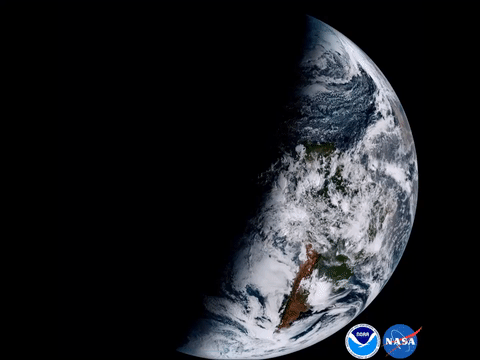
'Eyes in the Sky': Free Space-Focused Curriculum Brings Satellite Views to the Classroom

Carie Lemack is co-founder and CEO of DreamUp, the first company to bring space into classrooms and classrooms into space. A former national security policy expert/advocate and producer of an Academy Award-nominated film, Lemack is a proud alumna of Space Camp and a supporter of all space cadets reaching for the stars. Lemack contributed this article to Space.com's Expert Voices: Op-Ed & Insights.
Satellite images of Earth can evoke both awe and complacency. We have a duty, therefore, to take a second look at any such photo that can be our greatest means of humility and our grandest moment of hope. We must take many looks at this "blue marble" and never take for granted the precarious state of nature and the power of science.
Only by viewing Earth can we repair damage to it, from the flooded plains and ashen mountains of southern California to the soaked streets and storm-ravaged suburbs of Houston.
Only by changing our perspective can we perceive — and embrace — a new reality in which space-based research and satellite images allow us to see beyond what our eyes alone can detect. By observing the world from afar, we can actualize a vision of our planet as one worldwide ecosystem whose balance depends on our ability to transcend our differences and come together because of our common humanity, to see not the boundaries of nations but boundless opportunities to unite for the good of the planet.
How else can we learn that there is, indeed, a ripple effect between what happens in the Pacific and its impact on the Atlantic? How else can we accept that what we don't see can — and does — have a global impact on oceans, as well as the land where we live and the air that we breathe? How else can we inspire students to respect the environment, unless they educate themselves about the Earth?
My company, DreamUp, in partnership with the online teaching resource CraftED Curriculum, has developed a free space-focused curriculum called Eyes in the Sky. With this program, we aim to transform otherwise purely academic courses into an awesome snapshot of Earth where science is sensational, technology is tangible, engineering is educative and mathematics is majestic.

The goal of Eyes in the Sky is to use satellite images of Earth to give students a better understanding of how our planet is very much a living organism, where they can see for themselves how everything from climate change to local ecological changes can impact parts of the world thousands of miles away. Educators working with grade-school and high-school students can sign up for this free, customized program at dreamup.org/free-curriculum.
Get the Space.com Newsletter
Breaking space news, the latest updates on rocket launches, skywatching events and more!
By teaching science, technology, engineering and math — and doing so through a different vantage point — we can promote a cleaner planet, too. By inviting students to open their eyes, to see for themselves what no other generation has seen before, we can inspire a sea change among students and teachers, and colleges and universities around the globe.
We cannot miss this chance to see for ourselves what we must do, not just for our own self-interest but the interests of the planet and the survival of all species that live here.
By opening our eyes, we will open our minds to new ideas and novel ways to address everything from climate change to school curricula concerning space and science. Students will be able to see how their efforts, through the power of science, can turn a dry lake bed into a resurgent source of life, or how protecting a forest can expand so many acres of greenery, for example — all of it visible from space.
The Eyes in the Sky will keep our eyes on the prize.
Follow us @Spacedotcom, Facebook and Google+. Original article on Space.com.
Join our Space Forums to keep talking space on the latest missions, night sky and more! And if you have a news tip, correction or comment, let us know at: community@space.com.









